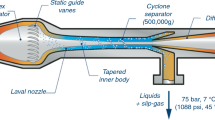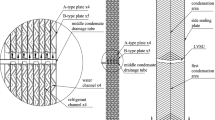Abstract
Vapor separator is a vital component in liquid-dominated steam field equipment. While various designs exist, the currently employed separator design was not so effective on separation and there is limitation in understanding the fluid behavior within the separator. Challenges arise from the difficulties in predicting the pressure distribution, flow regime and separation efficiency inside the separator vessel. Owing to this complexity, computational fluid dynamics (CFD) simulation of two-phase fluid movement inside a vapor separator was carried out using Cosmos Express software package. The modifications made to the existing vapor separator were done considering the major mechanisms such as gravity separation, inertial separation, centrifugal separation and surface tension force. This paper describes the CFD analysis of a modified vapor separator model. The design modification made in this vapor separator was to increase the efficiency of the system by reducing its drawbacks. The effect of turbulence and pressure drop on the existing vapor separator design was studied while improving their efficiency to 100% and 99.5% in two different designs. The separator efficiency was calculated by injecting water droplets after a converged solution was achieved. Though, pressure drop inside the vapor chamber is higher (1344.91 N m−2) for the first design compared to later having a lower value of 817.68 N m−2. CFD simulation results demonstrated a promising method to optimize the separator design.







Similar content being viewed by others
References
Pall Corporation. http://www.pall.com/main/fuels-and-chemicals/liquid-gas-separation-technology-5205.page.
Ion IV, Popescu F, Rolea GG. A biomass pyrolysis model for CFD application. J Therm Anal Calorim. 2013;111:1811. https://doi.org/10.1007/s10973-012-2552-7.
Atyabi SA, Afshari E. A numerical multiphase CFD simulation for PEMFC with parallel sinusoidal flow fields. J Therm Anal Calorim. 2019;135:1823. https://doi.org/10.1007/s10973-018-7270-3.
Scott SM, James D, Ali Z, et al. Optimizing of the sensing chamber of an array of a volatile detection system. J Therm Anal Calorim. 2004;76:693. https://doi.org/10.1023/B:JTAN.0000034891.68585.4a.
Hanfei T, Pega H. Vapour liquid separation in vertical impact T-junctions for vapour compression systems with flash gas bypass. Int J Refrig. 2014;40:189–200.
Hanfei T, Pega H. Enhancement of vapor liquid separation in vertical impact T-junctions for vapor compression systems with flash gas bypass. Int J Refrig. 2014;40:43–50.
Wenzhong G, Changsong L, Changda X, Dong W. Experimental study on water separation process in a novel spray flash. Desalination. 2016;386:39–47.
Bent W. Fundamental principles for sizing and design of gravity separators for industrial refrigeration. Int J Refrig. 2011;34:2092–108.
Funahashi H, Hayashi K, Hosokawa S, Tomiyama A. Study on two-phase swirling flows in a gas–liquid separator with three pick-off rings. Nucl Eng Des. 2016;308:205–13.
Hernandez-Martinez JL, Martinez-Ortiz V. A method to size gas–liquid horizontal separators handling nonstable multiphase streams, Society of Petroleum Engineers. SPE Latin America and caribbean petroleum engineering conference, 21–23 May, 2014. Maracaibo, Venezuela.
Yongxue Z, Chan G, Hucan H, Guomin X. Experimental research and numerical simulation on gas–liquid separation performance at high gas void fraction of helically coiled tube separator. Int J Chem Eng. 2014;2014:1–9.
Cane Sugar hand Book, Chapter 12, 304 – 306.
Hugot E. Hand book of Cane Sugar Engineering, 3rd edn, Chapter 32, pp 537–539.
Kataoka H, Tomiyama A, Hosokawa S, Sou A, Chaki M. Two-phase swirling flow in gas–liquid separator. J Power Energy Syst. 2008;2(4):1120–31.
Laleh AP, Svrcek WY, Monnery WD. Design and CFD studies of multiphase separators—a review. Can J Chem Eng. 2012;90:1547–61.
Keshavar OM, Jafarian A, Shekafti MS. Dynamic simulation of a heat recovery steam generator dedicated to a brine concentration plant. J Therm Anal Calorim. 2019. https://doi.org/10.1007/s10973-018-7448-8.
Author information
Authors and Affiliations
Corresponding author
Additional information
Publisher's Note
Springer Nature remains neutral with regard to jurisdictional claims in published maps and institutional affiliations.
Rights and permissions
About this article
Cite this article
Vijayan, V., Vivekanandan, M., Venkatesh, R. et al. CFD modeling and analysis of a two-phase vapor separator. J Therm Anal Calorim 145, 2719–2726 (2021). https://doi.org/10.1007/s10973-020-09825-2
Received:
Accepted:
Published:
Issue Date:
DOI: https://doi.org/10.1007/s10973-020-09825-2




